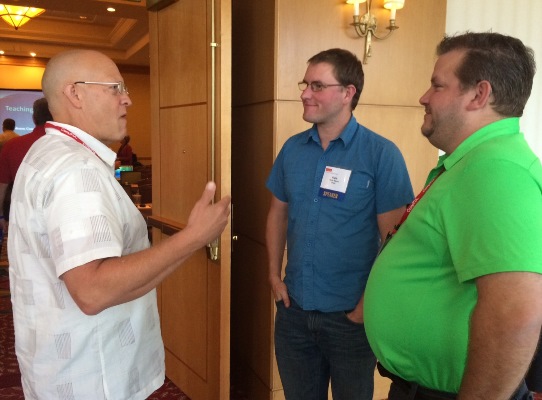by
Michelle Peterson
| Sep 08, 2014

iFixit CEO Kyle Wiens, center, spoke at CompTIA’s annual Academy Educator Conference to share ways his company is creating a "repair jobs revolution."
Back in 1990, “when dinosaurs roamed the earth,” joked Kyle Wiens, CEO of iFixit, people fixed things through trial and error, printed repair manuals or they went to a trade school to learn their skills. In today’s world — thanks in part to the online repair community he cofounded in his Cal Poly college dorm room — it’s Repair 2.0.
“You learn from the world,” he said. “iFixit wants to teach you how to fix everything in the world,” Wiens said to a room of educators at CompTIA’s Academy Educator Conference, describing his online repair community, internationally known for its open source repair manuals and product teardowns.
Like Wikipedia, iFixit uses collective knowledge for its community-contributed teardown and rebuild manuals. The site includes user-sourced repair manuals and troubleshooting help, plus hands-on lessons and learning tools. All of the manuals are available for free as online documents and downloads.
Wiens and his college roommate started the project because they were frustrated that many devices didn’t come with repair guides. “I believe that the knowledge of how to repair products belongs to mankind,” Wiens said.
Since its launch, iFixit has empowered millions of people to repair their broken technology – iPhones, vacuum cleaners, tablets. The site has 533 cell phone repair manuals, for example, and guides to repair 100 types of Macintosh products, plus a variety of PCs.
“We’re geeks and we like getting inside things and taking them apart,” he said. “I liked it enough that I figured out how to make it my job.”
iFixit is open source and free, and makes money by bits, screws, suction cups and other helpful tools, like a magnetic whiteboard that holds your parts plus your notes. “When you get down to phones these sizes, it can be more like watch repair than computer repair,” he said.
According to iFixit’s numbers, 91 percent of users said the site enabled them to fix their devices. “And 95 percent said a successful repair would make them more likely to buy the same kind of product again,” Wiens said. “That helps when we go to companies and say, ‘It’d be nice if your products were easier to fix.’”
Wiens said 26 percent of iPhones break within 24 months. “There’s a huge market opportunity for your students to get into mobile device repair,” he said. “If people can fix things, more things will get fixed and we can reduce the environmental impact of the IT industry.”
To get into an iPad, for example, you need heat. A factory professional might use a heat gun, but iFixit shows you tricks you can do at home to unglue the glass and pry it off using suction cups. “Suction cups aren’t in your usual PC repair tools, but they’re pretty useful for working in glass,” he said.
A Repair Jobs Revolution
“iPads are supposed to be the great textbook replacement, but they’ve got about three to four years of lifespan — if the student doesn’t drop it and break the screen first,” he said. Textbooks, on the other hand, are usually refreshed every five years. If teachers want to be able to use tablets instead of books, people are going to have to start learning to repair them — or spend a lot more money on equipment upgrades.
Wiens was hinting at an announcement made later in the week: A partnership between iFixit and the Microsoft Registered Refurbisher Program called the Pro Tech Network, a free, comprehensive program designed to make it easy for people to start new businesses fixing cell phones, tablets and computers. iFixit and Microsoft aim for this to create thousands of new repair businesses around the world.
“If we’re going to be training students to be iPad repair folks, what we need is a resource of training materials to show them how to run a business that can adapt,” he said. “It’s time for a repair jobs revolution.”
iFixit also includes an educational pillar, helping engineering students improve their English department scores by giving them hands-on projects that involve technical writing.
“We go to these poor, suffering literature professors and say, ‘What if we gave you a practical, hands-on project that students will get?’” he said. Having students write repair manuals, for example, lets them practice writing on something they’re actually excited about. Partner schools include SUNY Cortland, Ohio State University and the University of Louisville.
iFixit has also written a technical writing handbook, which includes everything from how to write to how to take clear, usable images. “It’s all publicly listed and open sourced because that’s just the way I think the world ought to be,” he said.
Later in the week, Wiens led Track4Techs: Not Your Father’s A+ at ChannelCon. Tune in to hear his talk, highlighting the importance of CompTIA A+ certification and how it’s changing along with the needs of the industry.
Michelle Peterson is a communications specialist for CompTIA.